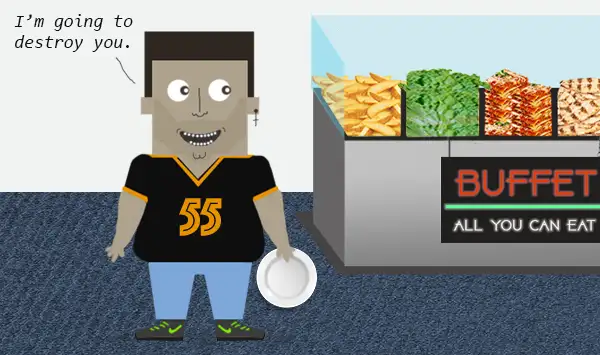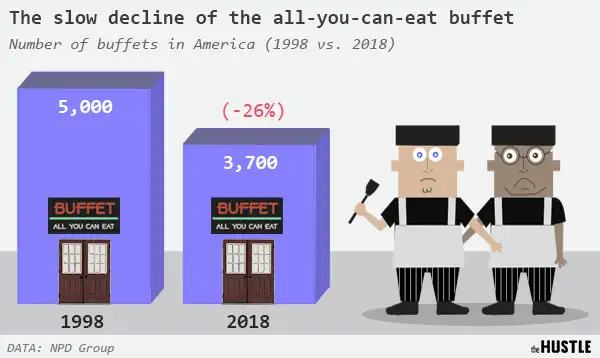How Do All You Can Eat Make Money
Few things epitomize America more than the all-yous-can-swallow buffet.
For a small fee, you're granted unencumbered access to a wonderland of gluttony. Information technology is a place where saucy meatballs and egg rolls share the same plate without prejudice, where a tub of chocolate pudding finds a home on the salad bar, where multifariousness and quantity reign supreme.
"The buffet is a celebration of excess," says Chef Matthew Britt, an assistant professor at the Johnson & Wales College of Culinary Arts. "It exists for those who want it all."
But one has to wonder: How does an industry that encourages its customers to maximize consumption stay in business?
To find out, we spoke with industry experts, chefs, and buffet owners. Equally information technology turns out, it's harder to "beat" the cafe than you lot might call up.
How a $twenty buffet breaks down
When you go to an all-y'all-tin can-swallow buffet, you pay a unmarried fixed price regardless of how much you eat. It doesn't matter if yous eat 1 plate or 10 plates: Each seize with teeth incurs an extra marginal cost to the eatery, but no extra cost to you.
We analyzed the prices of xxx all-you-can-swallow buffets beyond the state, taking into account a diversity of factors: Geographic region, size of the buffet (independent vs. chain), time of 24-hour interval (lunch vs. dinner), 24-hour interval of the week (weekday vs. weekend), and age (children and seniors ofttimes get discounted rates).
All considered, our analysis yielded an average buffet price of ~$twenty.
Enjoying this commodity?
Become the Hustle's 5-infinitesimal weekday roundup that keeps yous hip to happenings in tech, business, and internet… things.
Like virtually restaurants, buffets operate on extremely thin margins: For every $twenty in acquirement, $xix might go toward overhead, leaving $1 (5%) in net profit.

Zachary Crockett / The Hustle
Buffets often break even on food and eke out a profit by minimizing the toll of labor.
Self-service allows a buffet to featherbed a wait staff, and all-you-tin can-eat dishes (which are generally less circuitous and prepped in enormous batches) can exist made by a "skeleton crew" of line cooks.
"At a typical eatery, a cook tin service 25 customers per hour — and that's at best," says Joe Ericsson, a managing partner at the nutrient consultancy Eating place Possessor. "In the same amount of time, a single buffet melt might be able to prep enough nutrient for 200 people."
Because margins are so slim, buffets rely on loftier foot traffic: At Gilded Corral, a buffet chain with 498 locations in 42 states, dining floors are 5k-foursquare-feet and seat 475 people. On a typical Sabbatum, information technology's not uncommon for 900 diners to come through the door.
The volume of food required to satiate 900 all-y'all-tin can-eaters on a daily basis can exist staggering.
Each twelvemonth, Ovation Brands, the owner of multiple major buffet bondage, serves upwardly 85m dinner rolls, 47m pounds of chicken, and 6m pounds of steak — 49.3B calories in total.
It is estimated that between 5% and 25% of any given dish will be wasted, either through the cafe's miscalculation of demand or the diner's overzealousness. Waste reduction is a key focus of any successful buffet and a frequent tactic is reusing food.
"Buffets have always been a landing spot for nutrient scraps," says Chef Britt. "They telephone call them the 'trickle-down specials' — day-old vegetables or beefiness trimmings can be repurposed into a soup or a hash."
Buffets are also able to save coin by utilizing economies of scale and buying nutrient in bulk. Using data from a wholesale food supplier, we worked out the gauge price per serving of a few popular buffet items.

Zachary Crockett / The Hustle
Fully prepped, starches like potatoes might but cost the eating place $0.30 per serving, compared to $two.25 per serving for steak.
Past nature, buffets attract the very customers they wish to avoid: Big eaters with insatiable appetites. Buffets seek to "make full the customer's belly as cheaply and equally quickly as possible." To do so, they employ a number of research-backed tricks to get people to eat less food:
- They put the cheap, filling stuff at the forepart of the buffet line: (Study: 75% of buffet customers select whatever food is in the first tray — and 66% of all the nutrient they eat comes from the commencement 3 trays.)
- They use smaller plates. (Study: Smaller plate sizes reduce the amount of nutrient consumed.)
- They apply larger than average serving spoons for things like potatoes, and smaller than average tongs for meats.
- They frequently refill water and employ actress-large glasses.
Even higher-cease buffets, like the $98 brunch at the Hotel del Coronado in San Diego, use these tactics: "They hide the truffles, the foie gras, and the oysters," says Britt. "You literally can't notice them."
Merely what happens when a customer ignores these tricks and devours a Godzilla-sized portion of food? Is information technology possible to — cartel nosotros ask — out-swallow the all-you lot-can-eat buffet?
Buffets and the law of averages
Let's imagine that Larry, a 280-pound offensive lineman, decides to stop by his local all-you-can-eat buffet afterward a big game.
Larry's got a reputation around boondocks for existence a gourmand. He'due south got an appetite that puts Homer Simpson to shame — and on this detail day, he's set up to exercise some serious damage.

Zachary Crockett / The Hustle
Larry pays his $20 and proceeds to eat five servings of steak and chicken, far more than than the average customer.
The cost of this food to the cafe amounts to $xvi.90. This ways that afterward factoring in other expenses, Larry has handed the restaurant a loss of -$8.50.
Luckily, eaters like Larry ("vacuum cleaners," as 1 buffet owner calls them) are baked into any all-yous-can-eat buffet'due south pricing model. While the buffet might lose money on a modest number of meat gluttons, it handily makes it back on those who under-eat or just eat the cheaper foods.
"Nearly people don't become in and beat the cafe," says Britt. "They eat an appropriate amount, or even less than they should, averaging out the outliers."
Picture 3 diners: One who eats exactly the average toll of food to the restaurant ($7.twoscore), i who loads up on cheaper carbs ($four.lxx), and a guy like Larry:

Zachary Crockett / The Hustle
While the restaurant loses $8.50 on Larry, it makes $3.lxx from the under-eater and still takes in its steady $1 margin on the average eater.
And there are a lot more of the latter two patrons: The buffet owners we spoke with estimated that over-eaters like Larry just account for 1 in every ~20 diners.
Of the 300 diners that might come up through on a given day, this hypothetical buffet would see 255 average eaters ($225 profit), 60 undereaters ($222), and 15 gluttons (-$127.50). That works out to $320, or correct around that $1 profit per customer average. Annualized, the eatery is looking at a respectable $117k in pre-revenue enhancement profit.
Buffets don't end there: Many beef upwards their margins past selling soft drinks separately. At a cost of $0.12 per fill up, a $2 soda comes with a i,500% markup.
Nevertheless, buffets aren't impervious to extreme circumstances. Larry won't put a pregnant dent in a buffet'due south bottom line — but imagine if he brought the rest of his team with him.

Zachary Crockett / The Hustle
Every buffet owner nosotros talked to had a few war stories almost dealing with policy abusers. "All-you-can-eat," it seems, comes with certain limitations.
"There are people who become to a buffet and eat for 3 or iv hours straight," says Anna Hebal, owner of the Cherry Apple Buffet in Chicago. "They'll go to the bathroom, then come up back and eat again. They don't finish." She has since imposed a 2-hour time limit.
Other proprietors have taken more extreme measures. Over the years, buffets accept made headlines for boot out guests who eat too much:
- A 6'half dozen″, 350-pound Wisconsin human was removed from a buffet after downing 12 fried fish fillets (and subsequently arrested for protesting exterior).
- A German triathlete was asked to prematurely get out an $18.95 buffet after consuming 100 plates of sushi.
- A woman was booted from a Golden Corral for eating all the brownies, then attempting to smuggle dwelling extras in her purse.
To avoid these situations, some owners accept updated their language to "All-y'all-tin-swallow within reason," or resorted to charging customers extra for nutrient left on plates.
But the real enemy of the buffet isn't the occasional over-eater: Information technology's the steady march of technological progress, and the changing consumer preferences that have come up with it.
The end of the (buffet) line
According to the market place research firm NPD Group, the number of buffets in America has fallen by 26% since 1998 — even equally the total number of all restaurants in America has risen by 22%.
In the by 20 years, more than than 1.3k buffets have shut their doors. The big buffet chains that once dotted the Midwest have been striking the hardest: Onetime State Cafe is down to 17 of its 350 original locations; HomeTown Buffet has closed 217 of its 250 eateries; Ryan'south Cafe has downsized from 400 to 16.
Ovation Brands, the conglomerate that owns these chains, has filed for Chapter eleven bankruptcy iii times since 2008.

Zachary Crockett / The Hustle
Industry experts aspect this decline, in part, to the spread of food delivery apps. By 2030, the National Restaurant Association projects that fourscore% of all restaurant items will be eaten at abode — a trend that buffets can't effectively capitalize on.
Today'due south health-conscious consumers have as well shifted away from quantity in favor of experience-driven dining options.
Golden Corral, 1 of the last-standing American buffet chains, has constitute success by redesigning its dining spaces to be more "vivid, shiny, [and] friendly," and investing in higher-quality food that makes for better Instagram photos.
Anna Hebal, who runs a small buffet in Chicago, has a different strategy.
For 30 years, she has served guests a Polish-themed spread that includes kielbasa, schnitzel, and pierogi. Her secret? Sticking to the roots of what first made buffets popular in the 1970s: excess and variety.
"A cafe is just like life itself; you have and then many choices," she says. "It's up to y'all to choose wisely."
Go the 5-minute roundup you'll actually read in your inbox
Business and tech news in 5 minutes or less
Source: https://thehustle.co/the-economics-of-all-you-can-eat-buffets/
Posted by: stephensyough1967.blogspot.com

0 Response to "How Do All You Can Eat Make Money"
Post a Comment